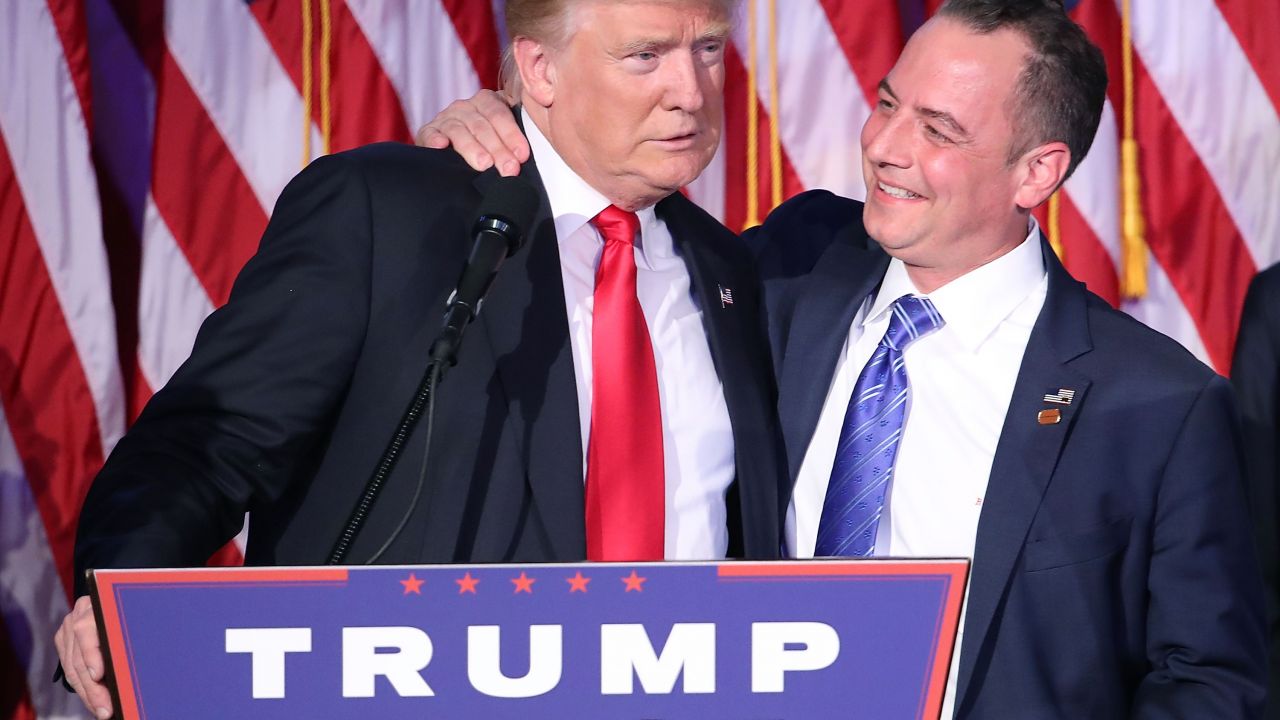
President-elect Donald Trump and Reince Priebus, chairman of the Republican National Committee, embrace during his election night event at the New York Hilton Midtown in the early morning hours of Nov. 9, 2016 in New York City. (Photo by Mark Wilson/Getty Images)
The newly unemployed Reince Priebus recently said on Twitter that the Republican Party is in the best shape it’s been since 1928.
And yet, a political circus daily assaults Americans. We have a demonstrably unfit Republican president, a Republican Congress unable to pass the measure on which its members campaigned for eight years, a revolt from military leaders against a presidential policy conveyed by tweet, and now an admission by Republican stalwarts former House Majority Leader Eric Cantor and Arizona Sen. Jeff Flake that Republican rhetoric was never more than a means to gain power. These things are not unrelated. We are witnessing the end of a political era, the era in which movement conservatism dominated America. We are seeing the nasty, snarling death of a political movement hatched in the 1950s to overturn the New Deal, fed on racism and sexism, fattened on hatred and lies, and now torn apart by its own acolytes.
That this political era would end badly has been clear since its beginning. Movement conservatism championed an ideology that was deliberately divorced from reality. Movement conservatives promised the impossible: to deliver prosperity to hardworking Americans by gutting the very programs that enabled them to prosper. Movement conservative leaders have managed to cover over the gulf between their promises and reality by promising the moon and then blaming Democrats for blocking their ability to deliver it. With President Trump now sharing power with a Republican Congress, Republican leaders are finally — and irrevocably — caught between their rhetoric and political reality.
As they promised, President Trump and today’s Republican Congress are dismantling the activist state that has protected economic and political stability since the 1930s. They are taking the American government back to the 1920s, to the days before the New Deal. They are the ultimate outcome of a political movement born in the 1950s, when business leaders set out to undercut FDR’s wildly popular New Deal, put in place by a Democratic Congress during the 1930s to stabilize the nation and enable Americans to climb out of the Great Depression. Democratic policies regulated business, provided a basic social safety net, and promoted infrastructure to help level the economic playing field that Republicans had in the 1920s tilted sharply toward business. Regular Americans loved the New Deal and, after Republican president Dwight D. Eisenhower accepted the idea that the federal government must intervene in the economy to keep things fair, it seemed that both parties had achieved a consensus that would dominate the future.
But reactionary Republicans wanted to destroy this new activist state that regulated business and levied taxes, and to break America’s bipartisan consensus they turned to racism. In 1954, the Supreme Court’s Brown v. Board of Education decision outlawed racial segregation in public schools. Three years later President Eisenhower mobilized troops to desegregate Little Rock’s Central High School. Federal efforts to promote racial equality enabled reactionaries to argue that these policies harnessed the government to the poor at the expense of everyone else. Government bureaucrats and troops required to enforce desegregation cost tax dollars, and thus, they argued, redistributed wealth from hardworking white men to lazy black people. An activist government was essentially communistic.
Movement conservatism gradually took over the Republican Party. It fueled the insurgent candidacy of Barry Goldwater in 1964; it was the key to his success in the only states other than his own that he carried: five states of the Deep South. Richard Nixon used the racism of movement conservatism to win in 1968 with what was known as the “Southern Strategy.” Twelve years later, Ronald Reagan made movement conservatism dominant in the party when he rode to the White House on his insistence that white tax dollars fed lazy black welfare queens. Reagan promised an end to regulation and tax cuts that would free white American men from the tyranny of an overgrown government.
But as Reagan’s presidency gave real power to movement conservative ideas, they began to run up against reality. Republican policies, especially those vaunted tax cuts, began to move wealth inexorably upward. The rich got richer while hardworking Americans, particularly people of color and women, fell farther and farther behind. When their policies did the opposite of what they promised, Republicans blamed “tax-and-spend” Democrats, who were sucking tax dollars out of “makers” and delivering them to minority and female “takers.” Increasingly, Republicans embraced an alternative reality, rejecting hard facts and science and believing instead that rhetoric created its own reality. As the gulf between rhetoric and reality widened, they insisted on ideological purity until believing Republican rhetoric over facts became a litmus test of party membership. By 2009, the idea that Democrats were catering to special interests in a form of race-based socialism was so deeply ingrained that Republicans could get away with trashing the norms of American government and simply refusing to work with Democratic president Barack Obama.
But now, the jig is up. In 2016, Republicans won the White House and Congress by ramping up their racism and sexism to full force, blaming Democrats for perverting the government by making it serve criminals and murderers. Republicans now have free rein to put their ideology into place. And this has brought them to a crisis. The reality is that they cannot actually gut the New Deal state and still keep voters on board. Even as Republicans excoriate government activism as redistribution of wealth to lazy minorities, Americans overwhelmingly support government regulation of business, social welfare legislation and infrastructure projects in general. In the past, Republicans could both promise to decimate the government and excuse themselves from doing so because they knew that Democrats would not actually permit it. It was a win-win. Republicans could cut taxes and deregulate business, which made rich supporters happy, while attracting voters by promising to cut programs to minorities.
Today, Republican leaders have no excuse not to follow through on their promises and, as they did in the 1920s, turn the government over to businessmen. And they have set out to do so. President Trump has refused to fill hundreds of positions in the executive branch, and has staffed Cabinet posts with business leaders openly hostile to the missions of their departments. He demands sweeping tax cuts and slashed budgets. For its part, Congress launched a repeal of the hated “Obamacare,” to liberate Americans from the oppression of a required health care mandate, with a bill that is, at its heart, a massive tax cut for the wealthy.
And suddenly rhetoric and reality have ripped apart. Americans have discovered that they liked the rhetoric of movement conservatism, but not the reality. They want government to protect them from hostile corporations, promote their basic welfare, and invest in infrastructure. That is, Americans still like the New Deal.
The American people have finally recognized the bankruptcy of movement conservative ideology. While it’s true that some have taken the racism and sexism of that ideology and have gone full-blown fascist, most Americans demand that the government return to the service of all of us rather than the rich alone.
As voters have pushed back against Trump and Congress, the president and his ilk have tried to square the circle by falling back on the racism and sexism inherent in their rhetoric, vowing to purge America of immigrants and fraudulent voters. Others, like Cantor and Flake, are doubling down on the idea that the problems in today’s Republican Party are ones of tone and temperament alone, and promise that if they can just get rid of the vulgar president, Republicans can regain the high ground of Barry Goldwater. But others seem to recognize that Republican ideological extremism has done the country no good. Rather than turning farther right, senators like Susan Collins, Lisa Murkowski and Lindsey Graham are reaching back toward reality.
They are the ones who are reading the future correctly.
This post is part of a three-part series in which historians examine Donald Trump’s plans to “Make America Great Again” and consider what point in American history President Trump was thinking about when he said “again.” Clearly, different voters heard different things. Now that we’re more than six months into his presidency, these historians review his legislation and policies and explain where that might place us in the past. Read other posts in the series.




